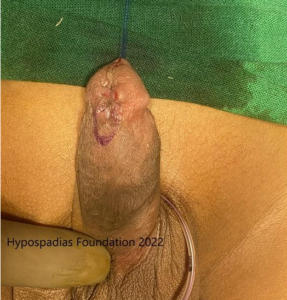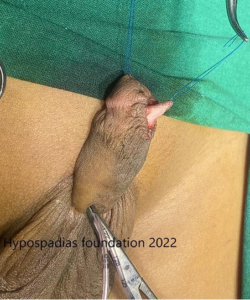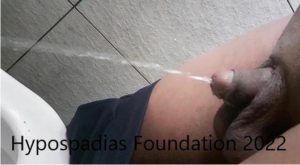

Fig 1 & 2: Clinical examination showing coronal fistula and glans bridge between meatus and fistula

Fig 3: Artificial erection test shows no residual chordee
Child was taken under anesthesia. As a first step, the bridge between the meatus and fistula was divided. A U- shaped incision was marked on the ventral penile skin at an equal distance from the corona to the proposed neomeatus. Incision was given at the marked site and stay suture was taken at the apex of the incision using 4-0 prolene. Incision was deepened and a flap of skin with thick vascular subcutaneous tissue raised. Glans wings were raised widely on either side. Flap was flipped distally to cover the urethral plate. Bilateral edge to edge anastomosis between the flap and urethral plate was done using 6-0 PDS over an 8Fr catheter. Local tissues closed as a second layer over the urethroplasty using 6-0 PDS. Glansplasty done. Penile skin beside the flap mobilized and skin closed in the midline using 6-0 PDS.
Post Op care: The catheter and dressing were removed on day 7. The child passed urine in a good stream without any complications of hypospadias repair. At 6 months follow up the child is doing very well without any issues.


Fig 4 & 5: U shaped incision marked. Incision deepened and flap raised.


Fig 6 & 7: Glans wings mobilized. Flap sutured to the urethral plate on either side and urethroplasty done.

Fig 8: Flip flap urethroplasty complete

Fig 9: Urine stream following catheter removal.
About Flip flap urethroplasty
The main aim of Hypospadias repair is to achieve a forward straight urine stream and normal or near normal looking penile appearance after hypospadias surgery. The important factors to be considered during any hypospadias repair are glans groove, urethral plate and chordee. Each patient with hypospadias is unique and these factors help us to decide the type of repair possible in them.
The case mentioned above had already undergone two hypospadias surgeries in the past but the surgeries were unsuccessful with formation of urethral fistula. However, he had a no chordee, wide urethral plate with healthy and mobile skin around the meatus. Taking into consideration these findings and the need for a short segment repair we decided to go ahead with flip flap urethroplasty for this boy. Flip flap urethroplasty is an excellent option of repair in failed cases with healthy penile skin with no scarring. This repair may be used in failed distal hypospadias repair in the absence of chordee with adequate meatal opening and flat urethral plate which cannot be tubularized.
At our centre the flip flap repair for failed cases has more than 90% success rate. Expertise in this area and proper case selection has helped us achieve excellence in treating even the most complex hypospadias.
About Hypospadias Foundation
Hypospadias Foundation is located at MITR hospital in Kharghar, Navi Mumbai in the state of Maharashtra. Every year we get children and adults from all around the country and the world in search of a cure for hypospadias. We have recently completed 14 years of hypospadias foundation and have successfully treated thousands of children and adults with hypospadias over the last 14 years. Our dedication, determination, and perseverance in the field of hypospadias has helped us achieve excellent outcomes.
Dr A K Singal is a top and expert surgeon who has dedicated his life in treating children and adults with hypospadias. His expertise in this area has helped us achieve excellent outcomes in adults and children with hypospadias.
Dr Ashwitha Shenoy is an expert pediatric surgeon with special interest in pediatric urology and hypospadias. Both Dr Singal and Dr Shenoy work together to give best results for hypospadias surgery in India for both children and adults.
